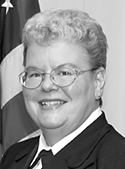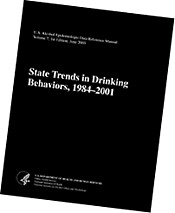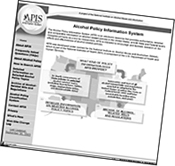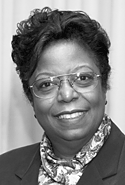
 |
 |
|
National Alcohol Screening Day (NASD) 2004 is Thursday, April 8th.
For information about registering to host NASD events, visit www.National AlcoholScreeningDay.org
Training sessions on how to run a successful NASD site are planned throughout January and February.
NASD is supported by NIAAA and the Substance Abuse and Mental Health Services Administration (SAMHSA), in partnership with Screening for Mental Health, Inc.
For details on dates and venues, see the NASD Web site or contact Sarah Lawler at 800/253–7658, ext. 113.
“What organizational structure would be most effective for the research mission of NIAAA in the near future?” This was the question posed by Dr. T.K. Li when he became director of NIAAA nearly one year ago. Since that time, Dr. Li and NIAAA staff have worked to develop a plan that will make the best use of staff and resources.
To ensure NIAAA’s organization would keep pace with an ever–changing and increasingly complex research portfolio, careful consideration was given to four key goals:
Last spring, Dr. Li held a retreat with division and office directors and branch chiefs to discuss ways to encourage communication within and across NIAAA. “Our goal was to structure the most effective NIAAA extramural research program,” said Dr. Li. “In weighing various options, we wanted to move away from the traditional hierarchical configuration in which people tend to think ‘up the chain’ rather than across the organization, and which can sometimes lead to research ‘silos’ or ‘stovepipes,’” he said. Following the retreat, Dr. Li also obtained input from staff at all levels through meetings and e–mail messages.
On October 1, 2003, several changes went into effect. NIAAA has consolidated four former offices into three offices—the Office of Scientific Affairs, the Office of Resource Management, and the new Office of Research Translation and Communications. The extramural research divisions then were re–aligned into four divisions—the Division of Neuroscience and Behavior, the Division of Metabolism and Health Effects, the Division of Treatment and Recovery Research, and the Division of Epidemiology and Prevention Research.
The Biometry Branch, formerly in the Division of Biometry and Epidemiology, is now part of the intramural research program, which was successfully reorganized in recent years by its director, Dr. George Kunos. (View the organizational chart on NIAAA’s Web site at www.niaaa.nih.gov/about/organization.htm.)
Finally, in keeping with the central vision of a cross–disciplinary approach to extramural research, NIAAA has created a number of Trans–Divisional Research Emphasis and Resource Development Teams. The teams are self–organized by NIAAA staff. Several are already under way, including teams focused on medications development, underage drinking, recovery and sobriety maintenance, community–based prevention research, fetal alcohol syndrome, and metabolomics and technology development.
Dr. Li noted, “While further refinements may be needed for efficacy and effectiveness, I am confident we have achieved a strong, flexible structure that will improve communication, facilitate scientific cross–fertilization, and strengthen the development of staff.”
 Dr. Faye Calhoun (center, at podium) presents a plaque to NC First Lady Mary Easley (bottom row, left) for her service in fighting underage drinking. |
More than 60 leaders from 40 colleges and universities joined North Carolina First Lady Mary P. Easley on September 24, 2003, for a summit to address alcohol problems on campuses throughout the State. They signed a pledge to take a multi–pronged approach by targeting individual at–risk drinkers, the student population, and college towns.
The summit highlighted research findings and recommendations from A Call to Action: Changing the Culture of Drinking at U.S. Colleges, a 2002 report that documents the extent of college drinking–related problems and offers evidence–based recommendations to address them.
Summit sponsors were NIAAA, the North Carolina Department of Health and Human Services, the Governor’s Institute on Alcohol & Substance Abuse, Inc., and Wake Forest University.
NIAAA Deputy Director Dr. Faye Calhoun spoke about alcohol research and highlighted discoveries about alcohol’s effects on the adolescent and young adult brain. She described NIAAA’s recent program announcement for rapid responses to conduct timely research for preventing or reducing alcohol–related problems among college students.
At a press conference during the summit, Mrs. Easley said, “As a college professor, lawyer, and the mother of an 18–year–old college student, I am concerned about alcohol’s devastating effects on our college students, whether they choose to drink or not.” Mrs. Easley is co–chair of the Leadership to Keep Children Alcohol Free, a national initiative to address underage drinking.
Wake Forest University President Thomas K. Hearn, Jr., speaking on behalf of the other school leaders, articulated their determination and unity to deal with alcohol–related problems on campus.
 |
Assistant Surgeon General and NIAAA deputy director Dr. Mary Dufour retired in September from NIAAA and the Public Health Service (PHS) after 21 years with the Institute. A physician epidemiologist and authority on the medical consequences of alcohol, especially its impact on women and the elderly, Dr. Dufour had a particularly influential role in the growth and recognition of the field of alcohol epidemiology.
Dr. Dufour joined NIAAA at a time when the Institute was making the transition from supplementing other national health surveys for information on alcohol consumption to conducting and funding studies that focused on alcohol use and its consequences. As chief of the epidemiology branch and eventually as director of the Division of Biometry and Epidemiology (DBE), she oversaw the design and implementation of major studies, including, most recently, the National Epidemiologic Survey on Alcohol and Related Conditions (NESARC). NESARC is the largest, most definitive longitudinal alcohol survey to date and will provide data on a wide range of alcohol–related issues.
Dr. Dufour served as both DBE director and NIAAA deputy director since 1995. She represented NIAAA and alcohol science to many constituencies. As an Assistant Surgeon General, she provided leadership to the PHS commissioned corps. As a board–certified pathologist, she consulted with other National Institutes of Health components on laboratory testing in patient care. NIAAA Director T.K. Li said, “Dr. Dufour has provided the leadership necessary to ensure that NIAAA research provided solid information about important knowledge gaps, including the particular impact of alcohol use on women and the elderly.”
A focal interest for Dr. Dufour has been research on women’s health. She served for 11 years on NIH’s Coordinating Committee for Research on Women’s Health. She co–founded and chaired the Interagency Coordinating Committee on Fetal Alcohol Syndrome and has served on numerous departmental and NIH task forces.
Dr. Dufour is a recipient of the PHS Commendation Medal and the Outstanding Service Medal, and has two PHS Outstanding Unit Citations. She joined NIAAA in 1982 as a fellow in the highly competitive U.S. PHS Epidemiology Training Program.
 |
Alcohol: A Women’s Health IssueReleased in September, this 20–page public education brochure is a companion to the award–winning video describing the health consequences of heavy drinking in women. The video, by the same title, has received numerous honors—a Telly Award, a bronze World Medal from the New York Festivals, a Gold Screen from the National Association of Government Communicators, and most recently a Merit Award from the National Health Information Awards. Women and Alcohol: An UpdateThe most recent issue of Alcohol Research & Health focuses on women and alcohol and features research about sex differences and genetic risk, minority populations, elderly women, osteoporosis risk factors, prenatal exposure to alcohol, and other issues. The journal is available at www.niaaa.nih.gov/publications/aharw.htm. |
 |
State Trends in Drinking Behaviors, 1984–2001Using data from the Behavioral Risk Factor Surveillance System, this 698–page manual presents prevalence estimates for drinking status and drinking level, 5+ drinks, and drinking and driving. The prevalence estimates are presented by state and year according to sex, age, race, Hispanic origin, education, marital status, and employment status. |
 |
Alcohol Problems in Intimate Relationships: Identification and InterventionThis manual, developed in collaboration with the American Association for Marriage and Family Therapy, is now available full text online in HTML or PDF format at www.niaaa.nih.gov/publications/niaaa–guide/index.htm. |
 |
APIS Web SiteNIAAA recently launched the Alcohol Policy Information System (APIS), a new tool that provides authoritative and detailed information on U.S. State and Federal laws and regulations related to alcohol. At www.alcoholpolicy.niaaa.nih.gov users can search and download alcohol–related policy data in several formats and at several levels of detail, up to and including full texts of laws and regulations. For more information contact APIS coordinator Gregory Bloss at 301/443–3865, or gbloss@niaaa.nih.gov. |
 |
The Party’s OverThis public service announcement (PSA) is aimed at 8th graders. The PSA and a fact sheet were distributed to more than 900 media outlets across the country. |
| Return to Top |
TO ORDER:These publications and many others are available from NIAAA. Order online
at http://www.niaaa.nih.gov,
or by fax at 703/312–5230. |
 |
Dr. Faye Calhoun has been named Deputy Director, NIAAA. Dr. Calhoun joined NIAAA in 1995 as associate director for collaborative research. Under her leadership, her staff built a broad portfolio aimed at fostering partnerships between the Institute and other government and non–profit agencies, and with national and international organizations. These programs include the expanded National Alcohol Screening Day program, the Spirituality and Alcohol Research Initiative, the alcohol research centers and institutional training grant programs, international research and training programs, programs to address health disparities and women’s health issues, the Interagency Coordinating Committee on Fetal Alcohol Syndrome (ICCFAS), and other key collaborations with other NIH institutes and Federal and non–Federal organizations.
Dr. Calhoun’s many professional awards include the NIH Director’s Award and the Research Society on Alcoholism (RSA) Seixas Award for Distinguished Service. As deputy director, Dr. Calhoun will continue promoting collaborative research and educational activities in areas of common interest across NIH institutes and centers as well as with other government departments.
Judge Linda Chezem accepted a special appointment on August 4, 2003, to work with NIAAA part–time. In her capacity as a judge, Linda L. Chezem, J.D., will be working with NIAAA staff as they partner with other agencies that support justice–system professionals. One of her interests is underage drinking as it relates to the appropriate adjudication of juvenile and family court cases. Previously, she served as a judicial fellow at the National Highway Traffic Safety Administration.
Dr. Markus Heilig, currently head of the clinical drug abuse research program at the Karolinska Institute in Stockholm, Sweden, will be joining NIAAA as chief of the Laboratory of Clinical Studies, Division of Intramural Clinical and Biological Research, in July 2004. Dr. Heilig has carried out both basic and clinical research, and his work has spanned topics from gene expression to treatment of addiction. He is particularly interested in translational research and in the area of the neurobiology of alcoholism. His research has focused on the neural mechanisms underlying motivation and emotion, with special emphasis on the stress response and anxiety, and on the neurobiological basis of drug and alcohol dependence. He is internationally recognized for his groundbreaking research on neuropeptide Y. He brings to this position a unique ability to translate preclinical basic neuroscience research into possible new treatments.
Dr. Robert Taylor, a member of NIAAA’s Advisory Council, will be increasing his time as an advisor to NIAAA. Dr. Taylor is a professor of pharmacology and medicine and chairman of the Department of Pharmacology, Howard University College of Medicine, and director of the Division of Clinical Pharmacology at Howard University Hospital. He will be assisting NIAAA with its clinical trial program and medications development and will help develop a recruitment center in Washington, DC, at the Cardozo Health Center.
Dr. Susan Farrell retired from NIAAA in October. Since 1999 she served as Acting Deputy Director of the Division of Biometry and Epidemiology.
Kelly Green Kahn left NIAAA to join the American Cancer Society. She joined NIAAA’s Office of Policy, Legislation and Public Liaison in 2000, serving as the NIAAA public liaison officer.
NIAAA will participate in or exhibit at the meetings and conferences listed below. For additional information or updates on these events, consult the sponsoring organizations.
|
Adolf Pfefferbaum, M.D. |
November 18
Mark Keller Honorary Lecture
“Alcohol–Induced Insult to the Living Brain: Views from Magnetic
Resonance Imaging” Adolf Pfefferbaum, M.D., director, Neuroscience Program,
SRI International and professor, Stanford University School of Medicine.
Masur Auditorium (Building 10) NIH Campus
9000 Rockville Pike
Bethesda, MD
Time: 1:30–3:30 p.m.
Contact: Nancy Colladay, 301/443–3860; Ncollada@willco.niaaa.nih.gov;
For information on CME/CE credits see the Web site: http://www.niaaa.nih.gov/conferences/conferences.htm
![]()
January 20–23
Community Anti–Drug Coalitions of America (CADCA) National Leadership
Forum XIV
Washington, DC
Contact: www.cadca.org/events/forum/forum14/default.asp
![]()
February 5
Meeting of National Advisory Council on Alcohol Abuse and Alcoholism, Open Session
Natcher Building
NIH Campus, 9000 Rockville Pike
Bethesda, MD
Contact: Ida Nestorio 301/443–4376; inestori@willco.niaaa.nih.gov
February 19
The 4th Annual Guze Symposium on Alcoholism
“Alcoholism and the Latest Genetics and Neuroscience Findings”
The Midwest Alcoholism Research Center
Washington University Medical Center
St. Louis, MO
Contact: www.missouri.edu/~marc/guze_main.htm
Training and Registration for National Alcohol
Screening Day 2004
For information about hosting NASD events and for details about training classes
planned in January and February, visit: www.NationalAlcoholScreeningDay.org
or contact: Sarah Lawler, 800/253–7658, ext. 113.
Published by the Office of Research Translation and Communications, NIAAA, NIH, DHHS
NIH Publication No. 03–5346
Web address: http://www.niaaa.nih.gov
E–mail: NIAAAnewsletter@nih.gov
Editor: Gregory Roa
NIAAA Office of Research Translation and Communications
Willco Building/Room 409
6000 Executive Blvd. MSC 7003
Bethesda, MD 20892–7003
Phone: 301/443–3860
Fax: 301/480–1726
![]()
Forward
this newsletter to a colleague.
| ||||||||||||||